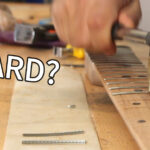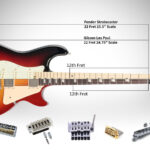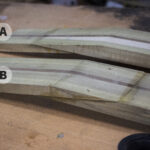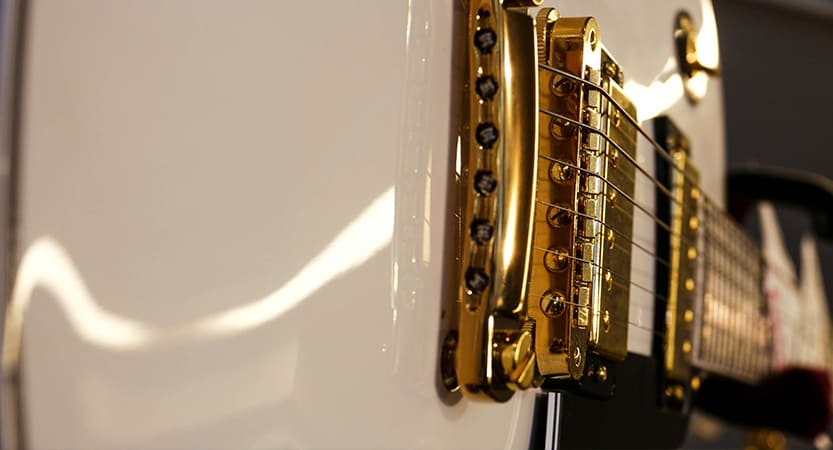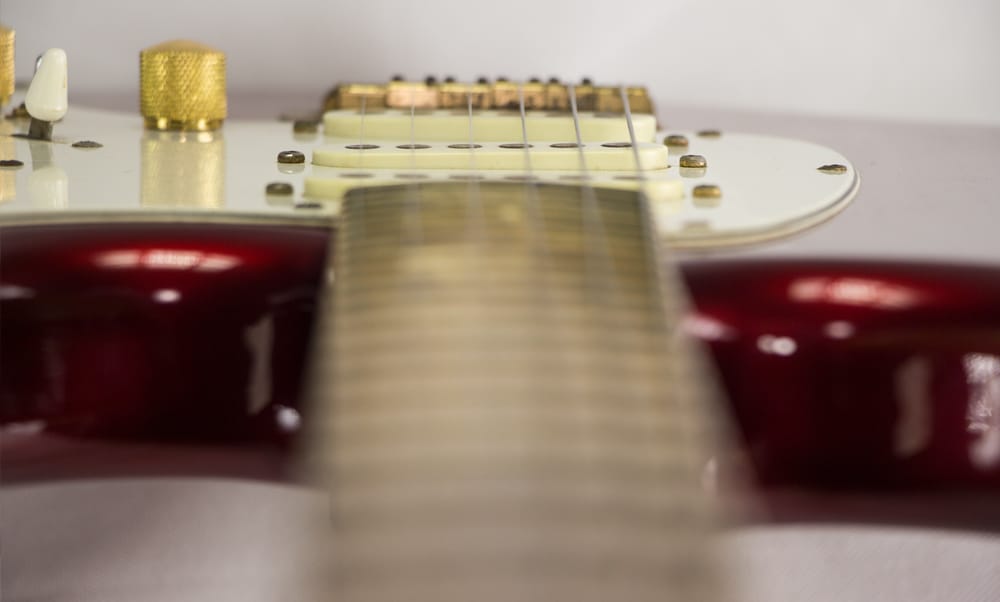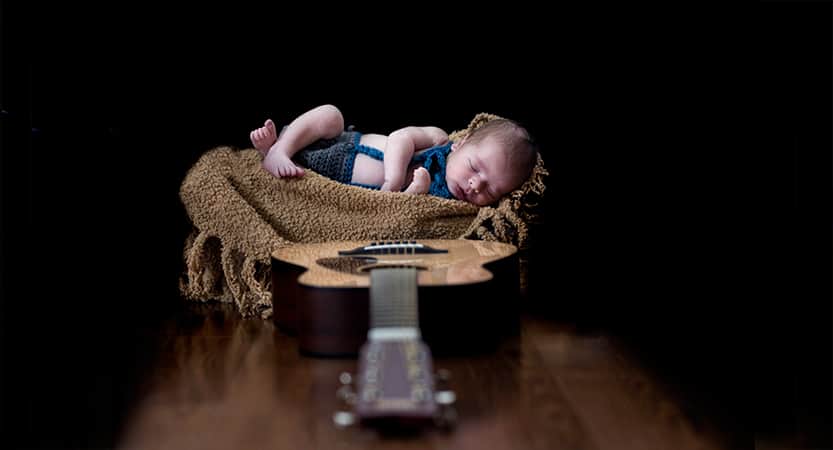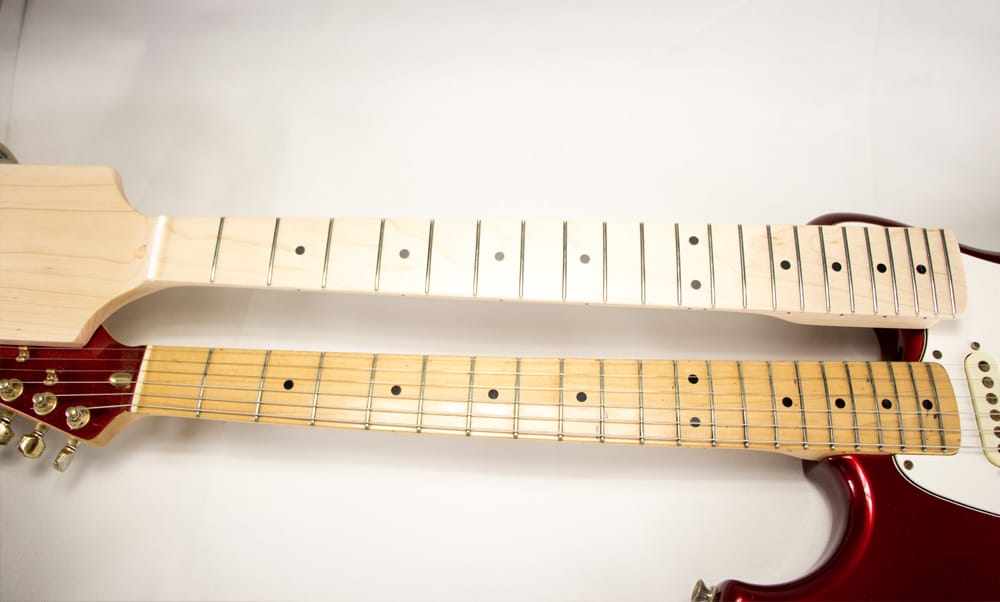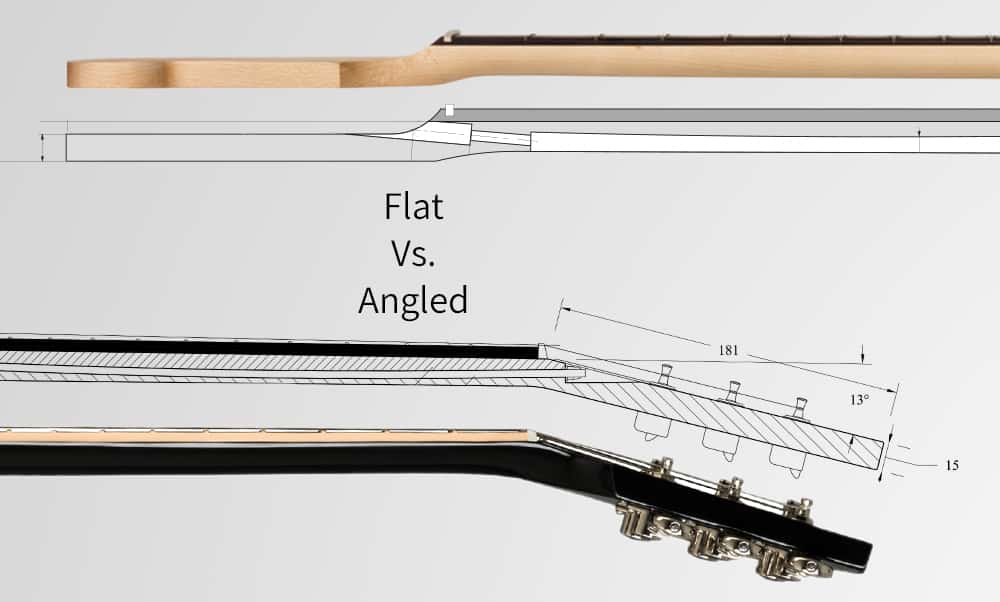When you first start building, Fixing or upgrading a guitar to any extent, you probably face a lot of parts, names and terminology you may have missed when simply playing.
The Main Parts of Acoustic and electric guitar are:
• The Head and tuners
• The Neck, Fretboard and Nut
• The Body, Bridge and Saddles
• The Pickups, Volume and treble, and Output Jack (Just for the Electric Guitar)
The electric guitar parts names naturally originated from the classic and acoustic guitars but a few of the parts are brand new or style specific.
Once guitars got electrified solutions were needed to make the best of the new technology and the door to innovation was opened. While maintaining the playability of the guitar a new set of parts were introduced to make the electric guitar what it is today.
The Anatomy of the guitar – Electric Vs. Acoustic
Both Acoustic and electric guitar share a large majority of parts as they are a necessity. The shapes may vary but more often than not the functionality stays the same. Luthiers and Guitar makers, Acoustic and electric alike, refer to the guitar as a loved woman and therefore many of the parts have names such as Body, Neck, Waist, Neck and Head
Common Parts
Head Stock
The Head of the guitar has a primary function of housing the guitar tuning pegs. The head is usually at an angle to the neck or lowered to have the strings sit firmly on an angle at the nut, give a cleaner sound and avoids them slipping sideways during playing. Most guitars will have between 11 and 17 degrees, ost Gibson Guitars are 14 or 17 degrees, and Fender Guitars have mostly Straight Necks which require ‘String trees’ to hold down the strings between the nut and the tuning Pegs.
Trivia Tidbit: Leo Fender Created the straight neck, that is now synonymous with Fender Guitars, in order to avoid wastage of large slabs of wood that were traditionally used to create the angle, make the production cost effective and maintain (if not improve) the strength.
The secondary function of the head is Branding. The shape of the head stock combined with the Log which is usually decaled or inlayed will identify the guitar maker or style. Premium models and custom shop may also have matching headstocks, which means the headstock will not have the generic look of the manufacturer, but will get the same treatment and finish as the body.
Tuning Pegs/ Machine Heads
Tuning Pegs are where the ends of the strings get tied and pulled. They are used to control the tension on each string and the ability to ‘tune’ it to the desired tension, pitch and tone. One of the important features of the Tuning peg, is to maintain tuning, and to prevent the bit of slack created by multiple windings of string around the pegs, there are Locking Tuners which eliminate the winding and have been growing in popularity as aftermarket upgrades. Traditionally acoustic guitars had a ‘Three and Three’ configuration, which carried over to Most Gibson models as well PRS, Rickenbacker and more. Spearheading the ‘Six Inline’ style of Machin Heads were Fender, with Ibanez, Washburn, Jackson and others to follow.
Nut
The Nut sits at the critical point between the neck and the head stock. It defines the top end of the playing part of the string. (The bridge being the bottom end) The nut also defines the spacing and the height, the action, between the strings and the frets. Traditionally Nuts are made of plastic, bone or ivory but with the growing popularity of Tremolo bars, which tend to take strings out of tune faster, there are more Locking Nuts aiming to hold the strings in place after tuning.
Neck
The neck gives us the length of the strings, withstands the force of the pulling strings and holds the fretboard. The necks of both acoustic and electric guitars (unlike classic guitars) houses a Truss Rod. A Truss Rod is a metal bar istalled along the length of the neck which gives it better rigidity and the ability to bend and straighten it.
Trivia Tidbit: Truss Rods were first introduced in the early 20’s by an engeneer at Gibson. On the other Hand the Guitar that later became the Fender Telecaster, was first issued with no Truss Rod in the early 50’s..
There are mainly two types of ways to connect the neck to the body: A bolt on neck, where the neck simply connected with four screws to the body, and set- in neck where glue gives the strength. There also Neck-through versions where the neck runs all the way to the bridge as on piece but are not as common. Electric guitar necks are usually thinner than their acoustic counterparts and have a bit more of a radius to better accommodate the natural curve of the hand.
Necks are most commonly made from maple, Mahagony and Ash.
Fretboard/ Fingerboard
The fingerboard is where a lot of the magic happens. Your fretting hand and fingers will spend all their playing time pressing those frets to shorten and lengthen the strings running along it. When you press a fre, the string only plays the new length between the bridge and the pressed fret, resulting in a different tone. Fingerboards are traditionally made from dark hard wood types such as Ebony or Rosewood, and demand the highest amount of precision from the Luthier. Most Guitars will have between twenty-one to twenty-four frets.
Frets Position Markers / Inlays
When you have twenty two frets or more, it’s a little difficult to figure out exactly where you are on the neck at any given time. Dots or other Markers are inlayed both on the top side of the neck (The thin Side – closer to the player) and on the front to give an indication of the fret Number. They are set at frets Three, Five, Nine, Twelve, Fifteen, Seventeen, Nineteen, Twenty one and Twenty four (if you have it). Frets Twelve and Twenty Four will usually be marked with two dots to indicate a full octave or two. Those inlayed dots are often made from ‘mother of Pearl’ or other ornamental materials and can also grow from a simple marker to a work of art by itself. I could be a simple shape to replace the dot, or a ‘drawing’ that expands along the whole fretboard.
Body
Structurally, the body is the single biggest difference between an electric and acoustic guitar. Still both have a somewhat similar shape. Electric guitars started out looking like a sort of an acoustic guitar, but gradually swayed to have their own styles and characteristics. There is still a debate among guitar enthusiasts to the extend of the effect the type of wood (tone-wood) has on the actual sound of the guitar. Whether a solid body or at any level of hollowness, the bodies are traditionally built from hard woods (not as hard and dark as the fretboard) such as Mahogany, Maple, Ash, Basswood and Alder, though many guitars have been built from other types of wood. The
Cutaway
Pretty much a standard with electric guitars although featured in some acoustic guitars, the cutaway is a mean to better reach the higher tones on the fretboard.
Binding
The binding in Acoustic guitar is practically part of the construction and a way to hide the connection of two thin pieces of wood, whereas in electrical guitars and especially solid body guitars it’s main reasoning is aesthetics.
Bridge/ Saddle
The bridge or saddle are the lower counterpart of the Nut. This where the strings stretch from towards the neck.
Unlike the Acoustic guitar, electric guitars have an adjustable neck or saddles in both position and height. The bridge or saddles can be moved forward and backwards for intonation adjustment, and they can move up or down to set the string Action
Strings
Acoustic and electric guitars share metallic strings. Although they each have designated string of different thickness, the playing, plucking and strumming is very similar. They all vibrate to give us sound. The main difference is the way that sounds reaches our ear. In an acoustic guitar we here it echoing from the body of the guitar. In An electric guitar we hear the amplification of the magnetic vibrations.
Strap Buttons/ Hooks
Some Acoustic guitars don’t have a place to connect a strap, pretty much all electric guitars do.
Unique to Acoustic
The obvious Body
Acoustic guitars rely on, well, Acoustics for their sound and volume. The large hollow body, the shape and the thickness all directly affect how an acoustic guitar will sound. The tone wood debate is controversial in electric guitars, what is agreed on is that the affect is much more prominent on an acoustic guitar, and the choice the type of wood and its treatment will affect the sound, volume and quality of the guitar.
Sound Hole
When it comes to acoustics, the sound has to travel out of the guitar body eventually. There are some guitars made with sondholes on the side or top of the body, but the majority is still in the center, just under the strings.
Bridge Pins
Since Acoustic guitars have a static bridge and a hollow body, these pins are all that is necessary to hold the ball end of the string. Since the ball of the string is pushed aside underneath the bridge, it’s pulling force cannot lift the pin and it stays in place.
Unique to electric
Pickups
The pickups are basically magnets wrapped with copper wire that translate the magnetic vibrations of the strings to an electric current. These are not microphones.
Selector
Most electric guitars come with more than one pickup and the number, type and styles of the pickups vary. The selector enables the player to choose which pickups or which combination of pickups he wishes to use at the moment. That can be changed with a flick of the switch.
Output Jack
Simply a way to connect the pickups to an amplifier without which the electric guitar will not be heard
Tremolo/ Vibrato/ Whammy Bar
A tremolo bridge enables, with a push or pull of a lever, to loosen or stretch all six strings simultaneously and create a unique sound effect. Once the lever is let go of, normal tuning should return. Since the introduction of The Fender Stratocaster in 1954 the tremolo bridge has gained massive popularity and there is a very wide range of aftermarket Tremolo bars and Bridges of different mechanisms.
Tone and Volume Knobs
There are different variations of controlling what type and strength of signal comes out of the output plug, but practically all electric guitars have the minimum controls for volume and tone. These are electric potentiometers the restrict and redistribute the electric current from the pickups to the output plug.
The Exception to the rule
These guitars are production guitars who do not adhere to the traditional or conventional.
The Gittler Guitar
This one pretty much defies everything I have just listed above. Gittler wanted to show that an electric does not need to be ‘constricted’ by the conventions of old guitars and got rid of all the unnecessary parts to be left with the bear minimum. Oh, and no wood.
The Steinberger guitars
Another distinctive design made from unconventional materials such as Graphite and Carbon Fiber these guitars are mostly noted for their Headless design.
Gibson EDS-1275 Double Neck
An extravagant model which combines a 6 string and a 12 string with an SG design. Made famous mostly by Jimmy Page when performing Stairway to Heaven and utilizing both neck.
Related Question
What are the internal parts of an electric guitar?
There is not much hidden from the eye.
- As mentioned before, the neck has the metal Truss Rod Running through it.
- Under the Selector, Volume and Tone Nobs are the pots (Usually 250k or 500k), capacitors, the selector itself, and electric wiring.
- In case of a Tremolo Bridge, the spring system will usually run through the back of the guitar.

